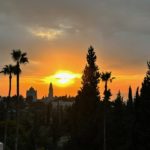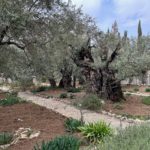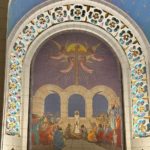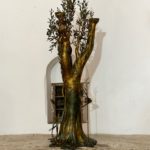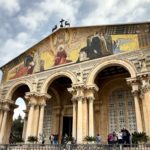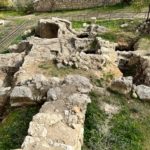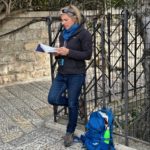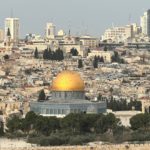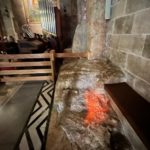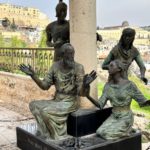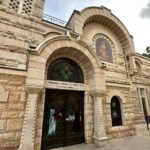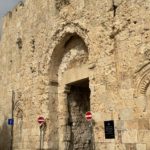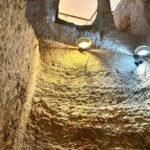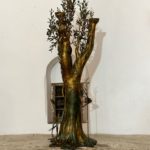Day 3 Jan 28
Cuxhaven I caught the early morning sun from the balcony of our hotel room! A new day! We were given a ready-to-hit-the-tourist trail time of 8:00 am! And even on the Sabbath!

View from Mt Scopus
After a buffet breakfast at the hotel (modified because of the Sabbath), we prepared to discover a few sites of the city of Jerusalem. We started with a visit Mt Scopus. Behind us was the main campus of the Hebrew University of Jerusalem as we stood on the overlook and gazed over settlements into Jordan.
Then we were off to the Mount of Olives, named for the olive groves that once covered its slopes. Between the Mount of Olives and the Old City is the Kidron Valley. Ancient rabbinic tradition holds that in the Messianic Era the resurrection of the dead will start here.
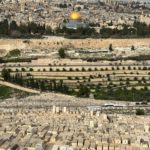
The cemetery in the foreground; Jerusalem’s wall in the middle ground.
Mount of Olives has been used as a Jewish cemetery for over 3000 years and has about 150,000 graves. According to the New Testament, Jesus visited the Mount of Olives three times during the week before his crucifixion and it is also the place from which Jesus ascended into heaven. In 70AD the infamous 10th Legion (Legion X Fretensis) camped here during the bloody siege of Jerusalem. A few graves of note are Eliezer ben Yehuda, the Father of Modern Hebrew, S Y Agnon, Nobel Prize for literature, and Israeli Prime Minister Menahem Begin.
After an orientation of some of the landmarks by Michal, our guide, we headed down the mountain to Gethsemane to see the church and garden, most famous as the place where Jesus prayed while his disciples slept the night before his crucifixion. Some of the trees in the garden have been carbon dated to the 12th century and some DNA tests have revealed that eight of them grew from cuttings of the same mother tree. The Church of All Nations, also known as the Basilica of the Agony, for the rock in the garden on which it is believed Christ prayed the night before he was arrested. A 4th century church here was destroyed in an earthquake in 747. Crusaders built a new one, aligned to cover three outcrops of rock, commemorating Christ’s three prayers during the night. It was consecrated in 1170 but fell into disuse after 1435. After excavations in the early 20th century, the present church was designed by Antonio Barluzzi and built in 1925 with funds from 12 nations, hence its name and the 12 domes bearing the national coats of arms. In the center of the nave ringed by a wrought iron crown of thorns is the rock of the Byzantine Church. The mosaic in the apse represents Christ’s agony, while others depict his arrest and Judas’ kiss.
We proceeded through Kidron Valley – or Valley of Josephat, which runs between the Old City and the Mount of Olives – to Mount Zion to visit the Church of St Peter in Gallicantu. This church commemorates the traditional site of St Peter’s denial of Christ, fulfilling the prophecy “Before the cock crows twice, thou shalt deny me thrice.” Built in 1931, the church looks modern but in the crypt are ancient caves where Christ is said to have spent the night before being taken to Pontius Pilate. The caves cisterns are what remains of the High Priest Caiaphas house/estate. There is a golden Rooster on the sanctuary roof and we took notice of Byzantine era mosaics found during excavation. As we stood on the terrace and gazed across the valley to the Mount of Olives, we were startled by gunfire coming from the Silwan neighborhood below. News reports indicate that a 13 year old terrorist armed with a handgun hid between cars and waited for a group to walk by. He wounded a father and his 22 year old IDF son who, though suffering a chest wound, was able to wound the attacker.
We visited the Cenacle, also known as the Upper Room, in David’s Tomb, traditionally held to be the site of the Last Supper. David’s Tomb is one of the most revered Jewish holy sites, but it was incorporated into a mosque by Muslims who consider David a true prophet. Today the entrance hall is still used as a synagogue, with separate seating for men and women. From the 4th to the 15th centuries, the tomb was associated with the Pentecost and the death of the Virgin Mary. According to tradition it was here that Christ washed the feet of his disciples after the Last supper.
We enjoyed lunch at a local restaurant located in a pilgrimage hotel/church complex called Notre Dame. The buffet had assorted foods – a bit of something for everyone. Afterwards, we returned to our hotel, the King David, with a free afternoon. Dinner tonight is on our own!
We walked through Blumfield Garden, a park near the hotel. We stumbled on Montefiore Windmill, a 19th century windmill that was one of the first structures outside the walls of the Old City.

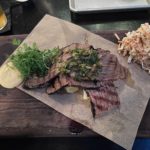 We strolled down to The First Station, a hodge podge conglomeration of fast food, eateries, shopping, bars, etc. set on the footprint of former train tracks and train shed, warehouses similar in design and structure to true industrial spaces. We found the Culinary Workshop, a meat lover’s dream. We started off with bacon wrapped shrimp with sour cream and balsamic vinaigrette on toasted pita triangles – sort of like nachos. Mike went for smoked brisket served on a cutting board with coleslaw. I decided on a burger and couldn’t eat but half!
We strolled down to The First Station, a hodge podge conglomeration of fast food, eateries, shopping, bars, etc. set on the footprint of former train tracks and train shed, warehouses similar in design and structure to true industrial spaces. We found the Culinary Workshop, a meat lover’s dream. We started off with bacon wrapped shrimp with sour cream and balsamic vinaigrette on toasted pita triangles – sort of like nachos. Mike went for smoked brisket served on a cutting board with coleslaw. I decided on a burger and couldn’t eat but half!

